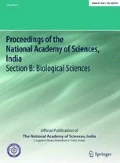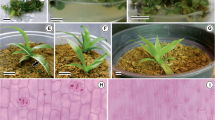Abstract
Well differentiated thalli of an ethnomedicinally potential liverwort Plagiochasma appendiculatum Lehm. & Lindenb. have been raised and multiplied in vitro in order to facilitate the availability of the living material in pure population for other experimental studies and maintenance of its germplasm. The ex plants (spores) inoculated into half strength Knop’s macronutrients and Nitsch trace elements along with 10 ppm freshly prepared ferric citrate, produced dichotomously branched thalli, while the same when supplemented with 1 % sucrose, produced a cluster of many well developed thalli within 12 weeks of culture. Multiplication of thalli was readily achieved by transferring of the apical portion of cultured thalli or innovations produced from cultured plants on fresh basal medium with above constituents. An enhanced growth has been observed in continuous light of 4,000–5,500 lux at a temperature of 21 ± 2 °C. In Murashige and Skoog medium explants showed improper growth, led to the formation of twisted and deformed thalli, while Gamborg B-5 medium produced callus like pulpy mass of undifferentiated tissue. Thalli developed in culture were acclimatized and transferred to soil for their further propagation where gametangial induction occurred at low temperature (16–18 °C) simultaneously with alternate light and dark condition of 10 and 14 h respectively.


Similar content being viewed by others
References
Madsen GC, Pates AL (1952) Occurrence of antimicrobial substances in chlorophyllose plants growing in Florida. Bot Gaz 113:293–300
McCleary JA, Sypherd PS, Walkington DL (1960) Mosses as possible source of antibiotics. Science 131:108
Banerjee RD, Sen SP (1979) Antibiotic activity of bryophytes. Bryologist 82:141–153
Basile A, Giordano S, Sorbo S, Vuotto ML, Ielpo MTL, Cobianchi RS (1998) Antibiotic effects of Lunularia cruciata (Bryophyte) extracts. Pharm Biol 36(1):25–28
Basile A, Giordano S, Lapez-Saez JA, Cobianch C (1999) Antibacterial activity of pure flavonoids isolated from mosses. Phytochemistry 52:1479–1482
Garnier GL, Bezanger B, Debraux G (1961) Resources medicinals de la flore francaise. Tome I, Vigot Freres Editeurs
Ando H, Matsuo A (1984) Applied bryology. In: Schultze MW (ed) Advances in bryology, vol 2. J. Cramer, Vaduz, pp 133–224
Glime JM, Saxena DK (1991) Uses of bryophytes. Today and Tomorrow Printers & Publishers, New Delhi
Nath V, Asthana AK (1995) Potential bryophytes—utility and future prospects. Appl Bot Abst 15:205–215
Pant G, Tewari SD (1989) Various human uses of bryophytes in the Kumaun region of North west Himalaya. Bryologist 92(1):120–122
Pant GB, Tewari SD (1990) Bryophytes and mankind. Ethnobotany 2:97–103
Singh AP, Asthana AK, Nath V (2000) Horitodbhid (Bryophytes) Ka Aushadhiya mahatwa—ek vivaran. Bharatiya Vagyanik avam Audyogic Anusandhan Patrika, New Delhi, pp 55–62
Frahm JP (2004) Recent development in commercial products from bryophytes. Bryologist 107(3):227–283
Banerji R (2001) Recent advances in the chemistry of liverworts. In: Nath V, Asthana AK (eds) Perspectives in Indian bryology. Bishen Singh Mahendra Pal Singh, Dehra Dun, pp 171–207
Huneck S (1983) Chemistry and biochemistry of bryophytes. In: Schuster RM (ed) New manual of bryology, vol-1). Hattori Botanical Laboratory, Nichinan, pp 1–116
Asakawa Y, Toyota M, Takemoto T (1978) Biologically active substances of bryophytes. Proc Bryol Soc Jpn 2:78–80
Asakawa Y, Toyota M, Taera Z, Takemoto, T (1982) Biologically active cyclic bisbenzyls and terpenoids isolated from liverwort. In: 25th Symposium on chemistry of natural products, Kaohsiung, Taiwan. Symposium paper pp 337–344
Parihar NS, Lal B, Katiyar N (1994) Hepatics and anthocerotes of India. A new annotated checklist. Central Book Depot, Allahabad
Joshi DY (2001) A floristc analysis of the liverwort from Andaman Island, India. In: Nath V, Asthana AK (eds) Perspectives in Indian bryology. Bishen Singh Mahendra Pal Singh, Dehra Dun, pp 135–148
Nath V, Nivedan A (2007) Studies on the variability of Plagiochasma appendiculatum L. et L. in India—I. J Econ Taxon Bot 31(1):189–198
Soni A, Kumar A, Nath V, Niveden A (2009) Genetic diversity of Indian liverwort Plagiochasma appendiculatum revealed by RAPD marker. Res J Bot 4(3):89–100
Kumar K, Singh KK, Asthana AK, Nath V (2000) Ethnotherapeutics of bryophyte Plagiochasma appendiculatum among the Gaddi tribes of Kangra valley, Himachal Pradesh, India. Pharm Biol 38(5):353–356
Singh M, Govindrajan R, Nath V, Rawat AKS, Mehrotra S (2006) Antimicrobial, wound healing and antioxidant activity of Plagiochasma appendiculatum Lehm. et Lindb. J Ethnopharmacol 107(1):67–72
Pryce RJ (1972) Metabolism of lunularic acid to a new stilbene by Lunularia cruciata. Phytochem 11:1355–1364
Asakawa Y (1990) Biologically active substances from Bryophytes. In: Chopra RN, Bhatla SC (eds) Bryophyte development: physiology & biochemistry. CRC Press, Boston, pp 259–288
Das VSR, Rao MP (1963) Non-volatile acids in liverworts. Nature 198:970
Asakawa Y (1981) Biologically active substances obtained from bryophytes. J Hattori Bot Lab 50:123–142
Sauerwein M, Becker H (1990) Growth terpenoid production and antibacterial activity of an in vitro culture of a liverwort Fossombronia pusilla. Planta Med 56:364–367
Ohta Y, Katoh K, Takeda R (1990) Growth and secondary metabolites in cultured cells of liverworts. In: Chopra RN, Bhatla SC (eds) Bryophyte development: physiology and biochemistry. CRC Press, Boston, pp 209–223
Decker EL, Reski R (2007) Moss bioreactor producing improved biopharmaceuticals. Curr Opin Biotechnol 18:393–398
Decker EL, Reski R (2008) Current achievement in the production of complex biopharmaceuticals with moss bioreactors. Bioprocess Biosyst Eng 31:3–9
Sabovljevic A, Sabovljevic M, Jackovic N (2009) In vitro culture and secondary metabolite isolation in bryophytes. In: Jain SM, Saxena PK (eds) Protocols for in vitro culture and secondary metabolite analysis of aromatic and medicinal plants series: methods in molecular biology. Humana Press, New York, pp 117–128
Mehra PN, Kachroo P (1951) Sporeling germination studies in Marchantiales 1. Rebouliaceae. Bryologist 54:1–16
Vishvakarma KS, Kaul A (1988) Influence of moisture level on growth of Plagiochasma appendiculatum Lehm. et Lindenb. and Reboulia hemispherica (L.) Raddi on a comparative basis. Cryptogam Bryol Lichenol 9(4):337–341
Knop W (1865) Quantitative Untersuchungen uber die Ernahrungsprozesse der Pflanzen. Landwirtseh Vers Stn 7:93–107
Kaul KN, Mitra GC, Tripathi BK (1962) Responses of Marchantia in aseptic culture to well known auxins and antiauxins. Ann Bot 26:447–466
Murashige T, Skoog F (1962) A revised medium for rapid growth and bioassay with tobacco tissue culture. Physiol Plant 15:466–473
Gamborg OL, Miller RA, Ojima K (1968) Nutrient requirements of suspension cultures of soybean root cells. Exp Cell Res 50:151–158
Voth PD (1943) Effect of nutrient solution concentration on the growth of Marchantia polymorpha. Bot Gaz 104:591–601
Salisbury FB, Ross CW (2002) Plant physiology. CBS Publications and Distributors, New Delhi
Mehra PN, Pental D (1976) Induction of apospory callus and correlated morphogenetic studies in Athalamia pusilla Kash. J Hattori Bot Lab 40:151–183
Allsopp A, Pearman C, Rao AN (1968) The effect of some growth substances and inhibitors on the development of Marchantia gemmae. Phytomorphology 18:84–94
La Rue CD, Narayanaswami S (1957) Auxin inhibition in the liverwort Lunularia. New Phytol 56:61–70
Benson-Evans K, Hughes JG (1955) The physiology of sexual reproduction in Lunularia cruciata (L.) Dum. Trans Brit Bryol Soc 2:513–522
Chopra RN, Sood S (1973) In vitro studies on reproductive biology of Riccia crystallina. Bryologist 76:278–285
Rawat M S (1976) Morphogenetic studies on some Bryaceae. PhD Thesis, University of Delhi, Delhi
Acknowledgments
The authors are grateful to the Director, C.S.I.R.—National Botanical Research Institute, Lucknow for encouragement and providing facilities. Thanks are due to the Ministry of Environment & Forests, Govt. of India, New Delhi for providing financial assistance.
Author information
Authors and Affiliations
Corresponding author
Rights and permissions
About this article
Cite this article
Awasthi, V., Nath, V. & Asthana, A.K. In vitro Study and Micropropagation of Ethnomedicinally Important Bryophyte: Plagiochasma appendiculatum Lehm. & Lindenb.. Proc. Natl. Acad. Sci., India, Sect. B Biol. Sci. 82, 405–412 (2012). https://doi.org/10.1007/s40011-012-0051-z
Received:
Accepted:
Published:
Issue Date:
DOI: https://doi.org/10.1007/s40011-012-0051-z




